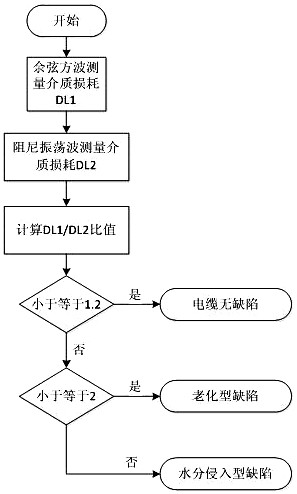Cable defect judgment method based on dielectric loss measurement under cosine square wave and damped oscillation wave
A technology of damping oscillating waves and dielectric loss, which is applied in the measurement of electrical variables, dielectric properties, resistance/reactance/impedance, etc., can solve the problems of lack of judgment standards and methods, and achieve the effect of simple methods
- Summary
- Abstract
- Description
- Claims
- Application Information
AI Technical Summary
Problems solved by technology
Method used
Image
Examples
Embodiment Construction
[0015] see figure 1 , a cable defect judgment method based on the measurement of dielectric loss under cosine square wave and damped oscillatory wave, the steps are as follows:
[0016] (1) Measure the dielectric loss value of the cable under cosine square wave voltage, denoted as DL1.
[0017] (2) Measure the dielectric loss value of the cable under the damped oscillatory wave voltage, denoted as DL2.
[0018] (3) Calculate the ratio of DL1 / DL2.
[0019] (4) When the ratio of DL1 / DL2 is less than or equal to 1.2, the cable has no defects.
[0020] (5) When the ratio of DL1 / DL2 is greater than 1.2 but less than or equal to 2, the cable is an aging defect.
[0021] (6) When the ratio of DL1 / DL2 is greater than 2, the cable is moisture intrusion type without defects.
[0022] The defect state of the cable can be divided into three types: no defect, aging defect and moisture intrusion defect. The dielectric loss values of these defects have different performances under dam...
PUM
 Login to View More
Login to View More Abstract
Description
Claims
Application Information
 Login to View More
Login to View More - R&D Engineer
- R&D Manager
- IP Professional
- Industry Leading Data Capabilities
- Powerful AI technology
- Patent DNA Extraction
Browse by: Latest US Patents, China's latest patents, Technical Efficacy Thesaurus, Application Domain, Technology Topic, Popular Technical Reports.
© 2024 PatSnap. All rights reserved.Legal|Privacy policy|Modern Slavery Act Transparency Statement|Sitemap|About US| Contact US: help@patsnap.com








